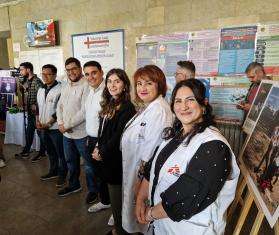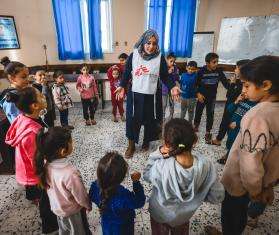Governments Must Commit to Massively Scale Up Treatment at UN Summit on AIDS
Governments will meet at the UN in New York for an HIV/AIDS Summit June 8-10 to discuss the future of the global response to HIV. Hanging in the balance will be the lives of the ten million people.

In the lead-up to June's United Nations summit on HIV/AIDS, Doctors Without Borders/Médecins sans Frontierès (MSF) is releasing a series of five videos that illustrate innovative tools and models that could help make improved HIV treatment accessible to many more who urgently need it.
My Life with HIV
Six years ago, MSF gave disposable cameras to six patients in our HIV clinic Kenya so that they could document their lives for a project called My Life With HIV. Now, ahead of a UN Summit on HIV/AIDS this week in New York, we've been back to visit them and to hear how their lives have moved on.
The Background
Governments will meet from June 8 to June 10 at the United Nations in New York for an HIV/AIDS Summit to discuss the global response to the epidemic over the next five to ten years. Hanging in the balance will be the lives of the ten million people who urgently need treatment, at a time when the latest science tells us that treating HIV not only saves lives, but also dramatically reduces—by 96 percent—transmission of the virus from one person to another.
Ten years ago, at the first major UN meeting on HIV/AIDS, then-Secretary-General Kofi Annan called for a “war chest” to respond to the epidemic. During the decade that followed, there was an unprecedented mobilization of political will and funding designed to get six million people on life-saving antiretroviral drugs (ARVs).
But much more is needed to break the back of the epidemic.
Much Accomplished, Much Work Ahead
MSF began treating HIV/AIDS in 2000, and has seen the tremendous positive effect treatment has had on people and communities. The number of deaths have been reduced and the consequences of the illness itself have been redefined. The introduction of ARVs has transformed HIV from a death sentence to a manageable chronic disease. More and more people are receiving treatment—now upwards of six million in developing countries—and there are new tools, treatment strategies, and innovations that can help caregivers reach even more people.
One major factor that allowed treatment scale-up to today’s levels was the dramatic reduction of the price of ARVs over the past decade—from more than $10,000 per patient in 2000 to roughly $150 today—which has made the lifesaving drugs accessible to millions of people in developing countries. The newer generation of ARVs also has fewer side-effects, which bolsters people’s ability to adhere to their treatment.
New Models Of Care
Another factor that has helped expand treatment is innovative care models, including those that bring the care closer to patients, to local community clinics and health posts. This has particularly improved access to treatment for people in remote rural areas who otherwise would struggle to find time and money to travel to distant central hospitals.
Models where patients are empowered to play an active role in managing their own treatment have also helped solve some of the distance-related issues and alleviate the burden on health systems. Moreover, shifting tasks from doctors to nurses—and in turn from nurses to lay workers—has reduced the pressure on overburdened health staff without compromising on quality of care.
The lessons learned over the last decade have shown us how to get care to people in developing countries. The World Health Organization now recommends people receive better-tolerated medicines, earlier in their disease progression, before they become very sick. This is an important step in the right direction. And there are other innovations on the way that could help us more easily reach even more people. New drugs and innovative formulations; new ways of producing drugs that could bring costs down further; simpler and easier-to-use diagnostic tools to monitor how patients are doing on treatment—all of these should soon help facilitate an even greater scale-up of treatment.
Promises Must Be Kept, Support Must Be Maintained
But to realize these goals, political will is required, as are financial resources from international donors and domestic investments in the countries affected. Scaling up treatment to all people in need will only be possible if leaders honor their past commitments by providing sustained funding and ensuring that drugs are affordable and available. Leaders also need to support policies to put effective treatment strategies in place and support the research and development of better, more affordable and simpler-to-use medicines and medical tools.
The job is far from finished. The lessons of how to reach more people with care, coupled with the critical new science that shows us treatment can help us get ahead of the wave of new infections, tell us that now is the time to push forward with ambitious plans to get treatment to people in need. There is simply no excuse for leaders and politicians to neglect the ten million people who will die without treatment in the next several years.





